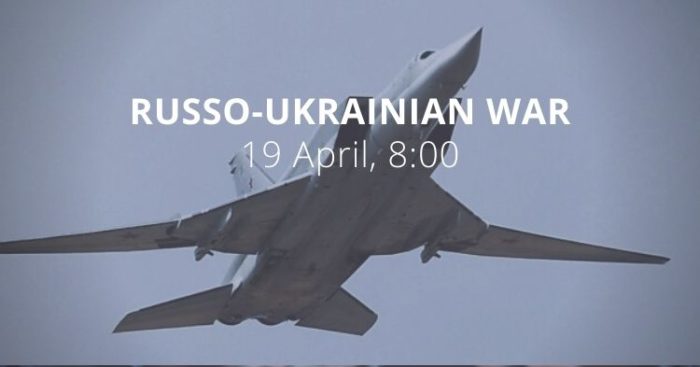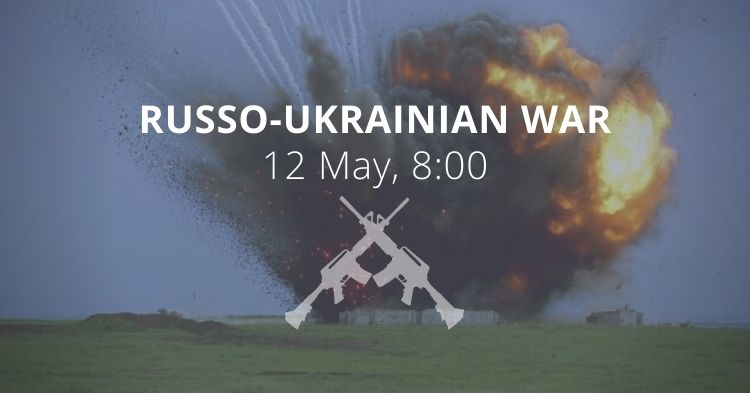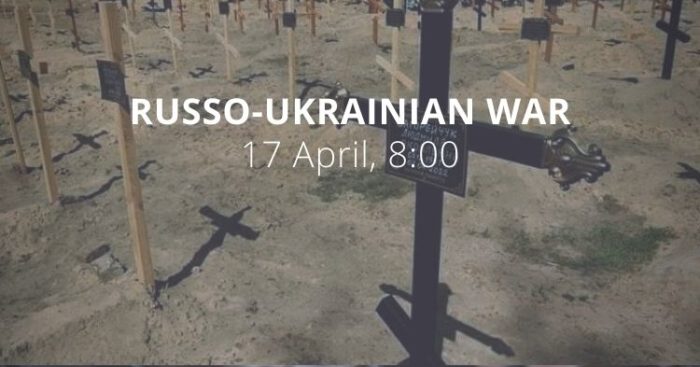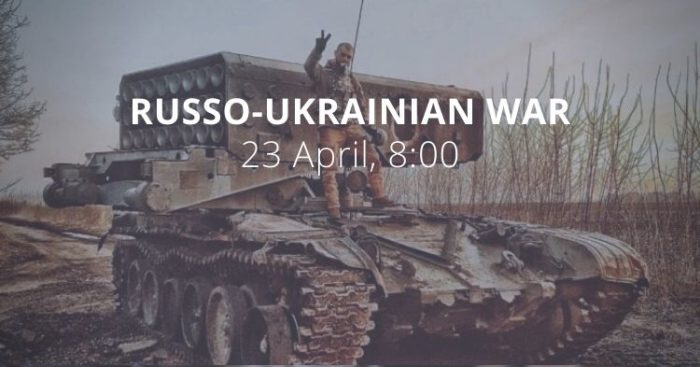Morning report day 55 – April 19
Situation
According to information from the General Staff:
Russian forces are trying to continue offensive operations in the Eastern Operational Zone in order to establish full control over the territory of Donetsk and Luhansk oblasts, as well as to maintain a land corridor with the temporarily occupied Crimea.
In order to strengthen the offensive capabilities, the Russian forces continue to form additional units in the Rostov Oblast and the temporarily occupied territory of the Autonomous Republic of Crimea. It is planned to use them to support the fighting of the main forces in the second echelon, protection of administrative buildings and important infrastructure in the occupied territories. According to available information, the approximate date of formation is April 24 this year.
Missile and airstrikes on civilian targets throughout Ukraine do not stop. There was the intensification of the Russian missile strikes on civilian objects in the western regions on the 18th of April
Provocative actions and the use of enemy aircraft by the Russian forces in the border areas of the Russian Federation with Ukraine are not ruled out, including strikes on civilian targets.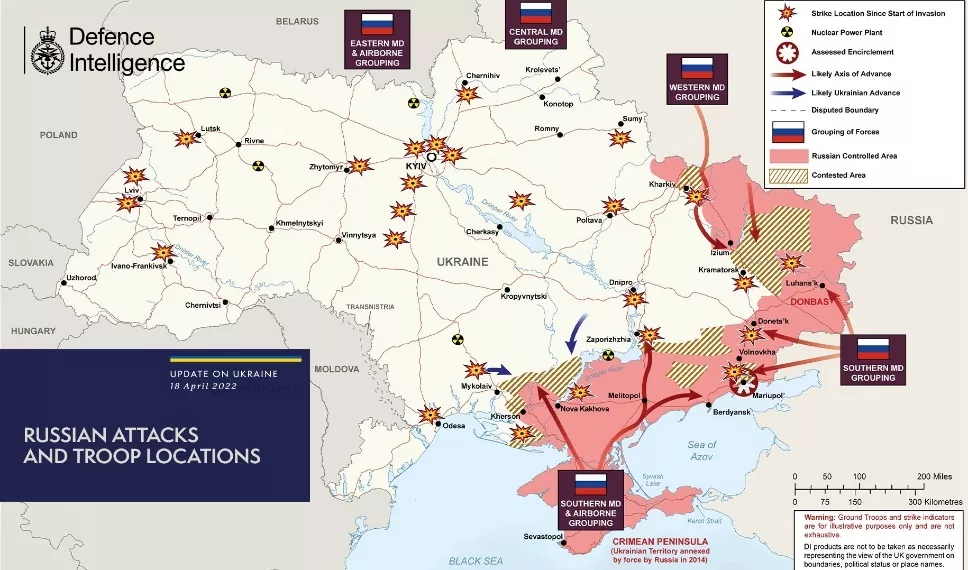
No significant changes have been recorded in the Volyn, Polissya, and Siversky directions.
- The Republic of Belarus continues to use and provide its territory for airstrikes on the territory of Ukraine and reconnaissance of objects on Ukrainian territory.
In the Slobozhansky and Donetsk operational districts, the Russian forces are conducting offensive and assault operations in certain areas.
- The Russian forces continue to transfer weapons and military equipment to Ukraine from the central and eastern regions of the Russian Federation. Along with combat units, it transfers support units.
- In addition, in order to improve the logistics system, the Russian forces are deploying logistics centers and creating field bases for repairing and renewing damaged equipment.
In the Slobozhansky direction, the Russian forces continue to partially block the city of Kharkiv. According to available information, in order to organize the air defense system of the offensive group, the Russian forces are transferring additional anti-aircraft missile divisions of short-range surface-to-air missile system "Tor" (SA-15 Gauntlet) to the Kharkiv Oblast. At the same time, mobile long-range surface-to-air missile divisions of S-400 (SA-21 Growler) and S-300 (SA-10 Grumble) were deployed in the areas of the Belgorod Oblast bordering Ukraine to cover the main command and control points, as well as the rear areas.
- In the Izium direction, the Russian forces are conducting offensive operations on the left bank of the Siversky Donets River. To support the offensive actions of the group in this direction, the enemy created a system of main and reserve firing positions for rocket and barrel artillery.
- In the Izium direction, the Russian forces operate in separate units of the 1st Tank Army, the 20th Guards Combined Arms Army of the Western Military District, the 35th and 68th Combined Arms Armies of the Eastern Military District, and the Airborne Forces. Attempts to advance in the Izium-Sloviansk and Izium-Barvinkove directions are expected to continue.
- In the area close to the state border with Ukraine, in the Belgorod Oblast, there is the deployment of helipads.
In the Donetsk and Tavriya directions, the Russian occupiers intensified offensive operations along the entire line of contact.
- The main efforts of the enemy are focused on breaking through the defense of Ukrainian troops in Luhansk and Donetsk oblasts, as well as establishing full control over the city of Mariupol. In the Zaporizhzhia oblast, the concentration of units of the Russian occupying forces continues in certain areas.https://twitter.com/EuromaidanPress/status/1516310032043945989?s=20&t=Vkpfp-krSDR6g96oVU6hwQ
- In the Donetsk and Tavriya directions, the Russian forces continue to focus their efforts on capturing the settlements of Lyman, Kreminna, Popasna, and Rubizhne, as well as establishing full control over the city of Mariupol.
- The Russian forces intensified offensive operations in the Sievierodonetsk, Popasna, Kurakhiv, and Zaporizhzhia areas.
- To increase efforts, the enemy continues to concentrate additional tank and artillery units.
- The battles for Mariupol continue. The Russian forces are storming the seaport.
In the Pivdennyi Buh direction, the Russian forces focus on reaching the administrative border of the Kherson oblast. In order to improve the tactical situation, the Russian forces are trying to conduct offensive operations in the area of the village of Oleksandrivka. The Russian forces do not stop the shelling of civilian objects in the city of Mykolaiv.
- It is fighting in the area of the settlement of Oleksandrivka, and it has no success.
In the Donetsk and Luhansk oblasts, Ukraine's defenders repulsed seven enemy attacks and destroyed ten tanks, eighteen armored units, and eight vehicles, one artillery system, and an enemy mortar.
The Air Force of the Armed Forces of Ukraine has hit seven air targets the day before: one plane, four UAVs, and two cruise missiles.
Russian naval groups in the waters of the Black and Azov Seas continue to isolate the seacoast of Ukraine, as well as conducting reconnaissance.”
Top Ukrainians say Russia’s eastern offensive is underway, but some analysts warn it has barely begun, The New York Times reports. “Top Ukrainian officials said the expected Russian offensive in eastern Ukraine had begun on Monday, but some of their colleagues and foreign military analysts described the action as merely the preliminaries to a much larger assault. Russia both conducted missile strikes throughout the country and stepped up its artillery and rocket attacks on cities, infrastructure, and military positions along the roughly 300-mile front, as Russian ground forces pushed forward there.”
The commander of the Azov Regiment, Lieutenant Colonel Denis Prokopenko, asks world leaders to organize an evacuation from Mariupol for civilians, wounded and dead soldiers who deserve to be buried with honors. “Right now, in Mariupol, at "Azovstal" steel factory hundreds of civilians are sheltering. Among them are people of all ages, women, children, and families of Mariupol defenders. They are sheltering in the basements and bunkers from the "Russian world".”
Russian forces know that civilians are hiding in the bunkers on Azovstal factory and they keep their fire willingly with free fall bombs, rockets, bunker-buster bombs, commander of Azov regiment Denys Prokopenko said. https://t.co/jkKY9xJfmB
— Euromaidan Press (@EuromaidanPress) April 18, 2022
The Armed Forces of Ukraine have liberated several settlements around the town of Izium in Kharkiv oblast, Ukrinform reports citing Oleksandr Motuzianyk, a spokesman for the Ukrainian Ministry of Defence. The town of Izium and its outskirts in the Slobozhanskyi direction has the largest concentration of Russian units. According to the Ukrainian General Staff, Russia has amassed up to 22 battalion tactical groups in the area of Izium.
Russians can resort to provocations on Easter, "alibi" already thought up, Ukrainska Pravda. The Center for Combating Disinformation at the National Security and Defence Council warns that Russian troops may resort to provocations on Easter holidays, accusing the Ukrainian army of them in advance.
"The occupiers are again using the technique of" information alibi ", warning of possible provocations in Ukrainian cities during Easter. In particular, several propaganda media reported that "more than 70 mobile groups have been formed from nationalists in cars that will fire mortars at Orthodox churches on Easter night, only to accuse the Russian military of doing so." At the same time, the propagandists provide a specific list of regions of Ukraine where this "may happen".
Ukrainian General Staff has reported on the Russian manning and logistic challenges:
- According to the available updated information, the losses of the 126th Coast Guard Brigade of the Black Sea Fleet are up to 75%. The 810th Independent Brigade of the Black Sea Fleet lost 158 servicemen killed, about 500 wounded, and 70 people missing.
- A significant number of servicemen of these brigades wrote reports refusing to participate in the so-called "special operation".
As of Tuesday 19.04.2022, the approximate losses of weapons and military equipment of the Russian Armed Forces from the beginning of the war to the present day: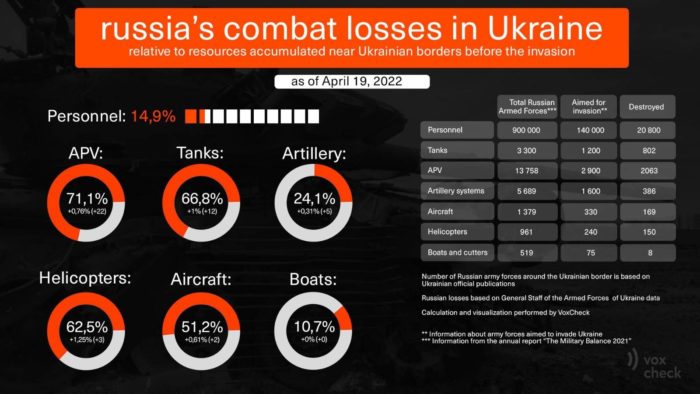
- Personnel – more than 20800 people (+200),
- Tanks – 802 units (+12),
- Armored combat vehicles – 2063 units (+22),
- Artillery systems – 386 (+5),
- Multiple rocket launchers – 132 (+2)
- Air defense means – 67 (no change),
- Aircraft - 169 (+2),
- Helicopters - 150 (+3),
- Automotive technology – 1495 (+8),
- Vessels/boats - 8 units (no change),
- Fuel and lubricant tanks – 76 (no change),
- UAV operational and tactical level – 158 (+3)
- Special equipment – 27 no change)
- Mobile SRBM system – 4 (no change)
Humanitarian
According to UNHCR 4,934,415 refugees have been registered as of 17 April. The UN says that so far Poland has taken in 2,780,913 refugees, Romania 743,880, Russian Federation 522,404, Hungary 461,539, Republic of Moldova 423,852, Slovakia 337,311 and Belarus 23,469. Among those who fled Ukraine are also Ukrainian nationals with dual citizenship. An additional 113,000 people moved to the Russian Federation from the Donetsk and Luhansk Oblasts between 21 and 23 February.
OHCHR recorded 4,890 civilian casualties in Ukraine as of midnight of April 17. 2,072 were killed (including 169 children) and 2,818 were injured (including 272 children).
https://twitter.com/EuromaidanPress/status/1516327583335555072?s=20&t=Vkpfp-krSDR6g96oVU6hwQ
On April 18, humanitarian corridors were not operational. According to the Deputy Prime Minister and Minister of Reintegration of Temporarily Occupied Territories of Ukraine:
“Yesterday we held long and hard negotiations regarding corridors from Mariupol, Berdiansk, Tokmak, Enerhodar. Also, we worked to enable corridors from the Kherson oblast. Definitely, negotiations included the cities of Luhansk oblast. Although violating international humanitarian law, Russian occupiers do not stop blockage and shelling of evacuation corridors.”
Environmental
A third of Ukrainian agricultural fields will not be used to sow wheat and other crops as a result of hostilities, Ukrinform reports. That’s according to the United Nations Office for the Coordination of Humanitarian Affairs in Ukraine.
“Up to 30% of agricultural fields in Ukraine won’t be used to plant wheat, barley, sunflowers, and corn this year. Ongoing hostilities may trigger global food catastrophe, as 36 out of 55 countries with food crises depended on Ukraine and Russian exports, reads the tweet by OCHA Ukraine.”
As many as 200 cultural heritage sites in Ukraine have been destroyed by Russian aggressors, Ukrinform reports citing Oleksandr Tkachenko, Minister of Culture and Information Policy.
"Russian troops are arbitrarily destroying our cultural heritage: churches, synagogues, museums, monuments, theatres. The Ministry of Culture and Information Policy has already recorded 200 damaged cultural heritage sites, and these figures are not final, Tkachenko said in a Telegram post.
According to him, Russia continues war crimes against the Ukrainian heritage, trying to erase Ukrainian history and identity. Destroying Ukrainian culture is one of their strategic goals in this war.”
Russia has destroyed up to 30% of Ukraine's infrastructure for $ 100 billion, Reuters reports. Reconstruction could be achieved in two years using frozen Russian assets to help finance it. Ukraine has not previously outlined the specific impact on infrastructures, such as roads and bridges, although officials say the total bill for damage to everything from transport to homes and other buildings runs to about $500 billion so far.
Kubrakov said more than 300 bridges on national roads had been destroyed or damaged, more than 8,000 km (5,000 miles) of roads had to be repaired or rebuilt and dozens of railway bridges had been blown up. He put the bill at $100 billion so far.”
Legal
The scale of Russian atrocities in Ukraine is staggering, the Editorial Board of the Washington Post writes. The atrocities revealed after the Russian retreat from Kyiv’s suburbs are not surprising in light of that history, but they shock the conscience nonetheless. Some 900 civilian bodies have been found, most of them shot dead at close range.
“The mayor of Mariupol has estimated that at least 21,000 civilians have died in the Russian siege, though that cannot be verified independently. His assertion that bodies were “carpeted through the streets” of Mariupol would seem extravagant but for Russia’s use of artillery and bombs against hospitals and schools — and the fact that independent journalists and human rights observers who have visited places such as Bucha have, indeed, found bodies lying in their streets.
Russia’s way of war, in short, includes war crimes. Certainly, the record of President Vladimir Putin’s previous campaigns offers no hint that anyone in the chain of command will be held accountable for excesses. On the contrary, confronted with unmistakable evidence of its troops’ culpability, Russia regularly issues official propaganda asserting that its enemy, in this case, Ukraine, has actually committed the atrocities so as to blame them on Russia.
https://twitter.com/EuromaidanPress/status/1516250432875728902?s=20&t=Vkpfp-krSDR6g96oVU6hwQ
Any decent end to this conflict would include a full investigation and punishment for war crimes. A realistic view, however, must acknowledge that actually putting Mr. Putin and his fellow perpetrators on trial is an aspiration, not a likelihood. Nevertheless, the world must not lose sight of Russian atrocities in the fighting to come, which, even when conducted outside of Ukraine’s cities, will put farmers and villagers in Russia’s path at risk. Russia’s behavior can and should motivate both Ukraine’s defenders and its supporters in the West to do anything within their lawful power to stop Russia from achieving its ends.”
The General Staff of Ukraine claims that:
- The Russian forces continue to cynically violate international humanitarian law, block initiatives to evacuate civilians from occupied settlements, refuse to coordinate humanitarian routes, and fire on areas near possible "green corridors."
- In the occupied territories, the Russian forces steal and export equipment, machinery, and products of local enterprises to the Russian Federation, bypassing agricultural fields.
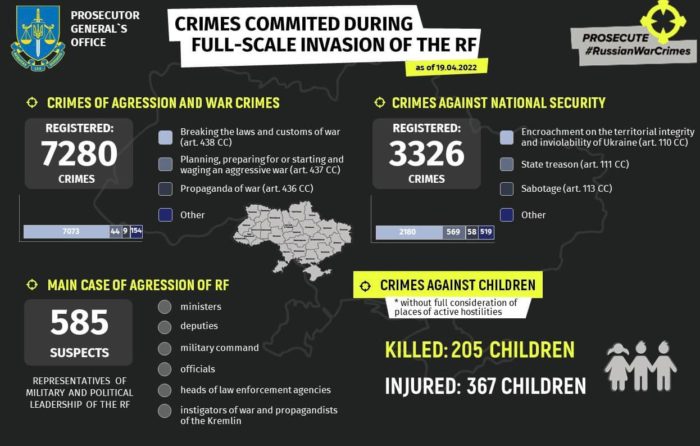 205 children were killed, and 367 children injured, the Office of the Prosecutor General of Ukraine reports as of 19 April. 1141 educational establishments are damaged as a result of shelling and bombings, 99 of them are destroyed fully. As of the same date, 7280 crimes of aggression and war crimes, and 3326 crimes against national security were registered.
205 children were killed, and 367 children injured, the Office of the Prosecutor General of Ukraine reports as of 19 April. 1141 educational establishments are damaged as a result of shelling and bombings, 99 of them are destroyed fully. As of the same date, 7280 crimes of aggression and war crimes, and 3326 crimes against national security were registered.
Support
The Stand Up for Ukraine campaign has raised €10.1B, Ukraine Business News reports. A campaign supporting Ukrainian refugees called Stand Up for Ukraine has raised €10.1B to date. This was announced in Warsaw by the President of the European Commission, Ursula von der Leyen. "The Stand Up for Ukraine campaign has raised €9B for people affected by the war, both in Ukraine and abroad, with an additional €1B promised by the EBRD, said Von der Leyen. The President of the European Commission called the amount received from the event "fantastic" and promised that "there will be more." "Ukraine's courage has already united the entire democratic world," he said, urging Western countries to impose additional sanctions on Russian banks and oil.
https://twitter.com/EuromaidanPress/status/1516258535578996737?s=20&t=Vkpfp-krSDR6g96oVU6hwQ
The United States will use instruments of economic and financial pressure, primarily against the Russian military-industrial complex, to destroy any opportunity for Russia to regain its potential during the war in Ukraine, Ukrinform
reports. This was stated on Monday during a speech at the Peterson Institute of International Economics by US Deputy Secretary of the Treasury Wally Adeem, Ukrinform reports.
To prevent this, we continue to try to use sanctions and export restrictions, deprive Russia of critical resources, and focus on key sectors such as the aerospace industry, electronics, and others related to the defense sector, said a spokesman for the US Treasury Department.”
Italy to send weapons to Ukraine, Ukrinform reports. The Italian Parliament has approved arms deliveries to Ukraine. This was stated by Prime Minister Mario Draghi in an interview with Corriere Della Sera. The decision to send weapons was made in parliament almost unanimously. Sanctions against Russia are needed to weaken the aggressor, but cannot stop the troops in the short term, Draghi added. Therefore, according to the head of government, Ukrainians need to be helped directly with weapons.
The United States will begin training the Ukrainian military with howitzers in the coming days, European Truth reports. The official said on condition of anonymity that the howitzer exercises would take place outside Ukraine. The United States plans to teach Ukrainian instructors how to use some of the new weapons, such as howitzers and radars, and then Ukrainian instructors will train their counterparts within Ukraine. It has previously trained Ukrainian forces to work with Switchblade drones.
The 155mm howitzer cannons are part of an additional $800m weapons package for Ukraine that US President Joe Biden announced last week.
The training of Ukrainians on how to operate these howitzers should start in the coming days.https://t.co/6lydRqtBCF— Euromaidan Press (@EuromaidanPress) April 19, 2022
Japan to provide Ukraine with drones, NBC suits, Ukrinform reports. The Ministry of Defence of Japan will send to Ukraine a batch of nuclear, biological, and chemical (NBC) suits and masks, as well as unmanned aerial vehicles, to help the country fight off a Russian invasion. That’s according to the Ministry’s official Twitter account.
World Bank to discuss 'next-phase' financing for Ukraine, Reuters reports. “More countries are expected to announce contributions to help war-torn Ukraine maintain its government through the World Bank's multi-donor trust fund and parallel funds this week, World Bank President David Malpass said on Monday. Malpass said the World Bank was working during spring meetings of the World Bank and International Monetary Fund to put together a $3 billion package of aid to help Ukraine maintain essential government services.”
A website for distance learning of Terror Defence soldiers has been launched by the Department of Training of the Headquarters of the Command of the Territorial Defence Forces of the Armed Forces of Ukraine. It already has online materials on fire training, tactical medicine, and physical training. This is meant as refresher training and is not a substitute for field training. It includes AK-74 rapid-fire course, instructions for the FGM-148 Javelin anti-tank missile system, tactical combat assistance course, rehabilitation exercises, etc., to increase the individual soldier’s ability to effectively resist the enemy. Materials on tactical training, survival in various conditions, military topography, communications training and other disciplines will soon be available.
Where does each EU country stand on cutting off Russian oil and gas, Euronews asks? EU ministers have been discussing a potential sixth round of sanctions against Russia over its invasion of Ukraine, but an embargo on oil or gas to stop financing Putin's war machine continues to divide the bloc. Austria has ruled out sanctions on imports of oil and gas from Russia. Germany, Europe's biggest economy, has been one of the most reticent to consider a total embargo on Russian energy. Hungary is very dependent on Russian energy and its nationalist prime minister opposes sanctions — although he has approved the ban on coal. Viktor Orbán has vowed to veto any attempt to impose an energy embargo because, in his view, it would "kill" his country. Luxembourg is currently divided over whether to further target imports of Russian gas and oil. Dutch Prime Minister Mark Rutte claimed the Netherlands could not cut off all fossil fuel supplies from Russia, saying they “need the supply” and this was the “uncomfortable truth.” Slovakia is very reliant on Russian fossil fuel imports as an energy source. The country takes around 85 percent of its gas and 66 percent of its oil from Russia, meaning cutting ties could have a significant impact on the central European state. Slovenia is significantly dependent on Russian gas and oil imports.
New developments
- Russia launches 'Battle of Donbas' on the eastern front, Reuters reports. “Russian forces have launched their anticipated offensive in eastern Ukraine, attempting to push through defences along almost the entire front line early on Tuesday in what Ukrainian officials described as the second phase of the war. Ukrainian President Volodymyr Zelenskyy said Russia had begun the "Battle of Donbas" in the east and a very large part of the entire Russian army is now focused on this offensive. Ukrainian media reported a series of explosions, some powerful, along the front line in the Donetsk Oblast, with shelling taking place in Marinka, Sloviansk, and Kramatorsk."
- Ceasefire “not on the horizon” in Ukraine, Ukrinform reports. “The Russians have launched a major offensive in Ukraine’s east so there are no preconditions for anyone to expect that hostilities will be suspended anytime soon. That’s according to Martin Griffiths, United Nations Under-Secretary-General for Humanitarian Affairs and Emergency Relief, Channel 24 reports. A ceasefire is not on the horizon right now, Griffiths said, adding that this could be possible in the coming weeks.”
- Biden to hold a call with allies on Tuesday over Ukraine invasion, Reuters reports. US President Joe Biden will on Tuesday hold a call with allies to discuss the Ukraine crisis, including how to coordinate on holding Russia accountable, the White House said.
- Putin gave the honorary title to the Russian brigade that staged the atrocities in Bucha, Ukrainska Pravda reports. The Russian president awarded the 64th Brigade, which occupied Bucha in the Kyiv Oblast in March, the honorary title of "Guards"." For mass heroism and courage, resilience and bravery showed by the personnel of the brigade in hostilities to defend the Fatherland and state interests in armed conflicts." ME: This is both a sign of defiance from President Putin, as well as a measure to support Russia’s false narrative that the atrocities in Bucha were “fake news”
- Kyiv has sent the first part of the membership questionnaire to the EU and is preparing the second, the European Truth reports. "The first part of the questionnaire on Ukraine's membership in the EU has been sent to the European Commission. As promised by President Volodymyr Zelenskyy, Ukraine has completed the document in a week! We have already started working on the second part. I am proud of the Ukrainian government team," Deputy Prime Minister for European and Euro-Atlantic Integration, Olga Stefanishina, wrote on Twitter.
Assessment
- On the War
The Institute for the Study of War has made the following assessment as of Monday 18 April:
The Russian offensive in the east is unlikely to be dramatically more successful than previous Russian offensives, but Russian forces may be able to wear down Ukrainian defenders or achieve limited gains. Russian forces did not take the operational pause that was likely necessary to reconstitute and properly integrate damaged units withdrawn from northeastern Ukraine into operations in eastern Ukraine. As we have assessed previously, Russian forces withdrawn from around Kyiv and going back to fight in Donbas have, at best, been patched up and filled out with soldiers from other damaged units, and the Russian military has few if any, cohesive units not previously deployed to Ukraine to funnel into new operations.
Frequent reports of disastrously low Russian morale and continuing logistics challenges indicate the effective combat power of Russian units in eastern Ukraine is a fraction of their on-paper strength in numbers of battalion tactical groups (BTGs). Russian forces may certainly be able to wear down Ukrainian positions in eastern Ukraine through the heavy concentration of firepower and sheer weight of numbers, but likely at a high cost. A sudden and dramatic Russian offensive success remains highly unlikely, however, and Ukrainian tactical losses would not spell the end of the campaign in eastern Ukraine, much less the war as a whole.
Russian forces likely began large-scale offensive operations in Donetsk and Luhansk oblasts on April 18. Ukrainian President Volodymyr Zelenskyy, the Ukrainian General Staff, and the Ukrainian Secretary of the National Security and Defence Council all stated that Russian forces began a new phase of large-scale offensive operations in eastern Ukraine on April 18. Russian forces concentrated on Popasna, Rubizhne, and Marinka. Luhansk Governor Serhei Haidai stated that Russian forces captured Kreminna, directly northwest of Rubizhne, but did not make any major gains elsewhere along the line. Social media footage depicted heavy fighting ongoing in Rubizhne and Popasna. Russian forces conducted heavy air and artillery strikes along the line of contact. Russian forces may be able to make advances in eastern Ukraine by dividing Ukrainian forces among many small axes of advance, but Russian offensive operations are unlikely to be dramatically more successful than failed operations around Kyiv, as ISW has previously discussed.
Key Takeaways
- Russian forces likely began large-scale offensive operations in Donetsk and Luhansk oblasts focused on Rubizhne, Popasna, and Marinka.
- Russian forces may be able to gain ground through the heavy concentration of artillery and numbers. However, Russian operations are unlikely to be dramatically more successful than previous major offensives around Kyiv. The Russian military is unlikely to have addressed the root causes—poor coordination, the inability to conduct cross-country operations, and low morale—that impeded prior offensives.
- Successful Ukrainian counterattacks southeast of Kharkiv will likely force Russian forces to divert some units intended for the Izium offensive, but Ukrainian forces are unlikely to completely sever Russian lines of communication north of Izium in the coming days.
- Ukrainian defenders in Mariupol continued to hold out against heavy Russian artillery and air bombardment.“
The US believes that Russia is learning from its failures in the north of Ukraine, where they did not have the proper capabilities to sustain military operations, and applying those lessons to their new focus in the east and the south of the country, CNN reports citing a senior US defense official.
"What we have seen over the last few days is them continue to try to set the conditions, the senior defense official said in a call with reporters on Monday. We call it shaping operations.
It appears as if they are trying to learn from the failed lessons of the north where they didn't have proper sustainment capabilities in the area they were about to operate, the official said.
The official said that the US has seen Russia moving in heavy artillery, command and control enablers, and aviation, particularly rotary aviation support as part of the 11 new battalion tactical groups that have moved into the east and south of Ukraine over the last few days. …
The US assesses that Russia has added 11 battalion tactical groups (BTGs) to their forces in the east and south since late last week, according to the senior US defense official, bringing Russia's total number of BTGs to 76.
"They have added to their capability inside Ukraine," the official said. The official said that all Russian ground forces are currently focused on the east and south of Ukraine, but the US is unable to pinpoint exactly how the new BTGs are spread out."
Military intel chief believes Russia not to achieve any wins in Ukraine by Easter as Kremlin wishes, Ukrinform reports. The Russians are intensively preparing for a decisive battle that will unfold in the east of Ukraine, expecting to gain ground by Easter. However, the occupiers won’t succeed, says Ukrainian military intelligence chief, Major General Kyrylo Budanov according to ArmyInform.
"The Russians are preparing for a decisive battle, they are in a hurry because they are very limited in time, they really want to gain at least some advantage and real tactical achievements that they would be able to present as some kind of win for Russia in their ‘operation.’ They are in a rush to make it happen by Easter,” Budanov said.
At the same time, he noted that despite possible temporary tactical gains, the Russians will not succeed, and Ukraine will withstand the onslaught. …
He also assessed the likelihood of Russia employing nuclear weapons
, noting that the Kremlin is voicing such threats only to raise stakes.
"This is solely a threat. If Putin loses his mind completely and tries to do so, first, even technically, it is not so easy. Indeed, he may try to do it but it is unlikely that he will. This is an element of bargaining, an element of blackmail of the whole world, and everyone understands this," Budanov said.
As Ukrinform reported earlier, Oleksandr Motuzyanyk, a spokesman for the Ministry of Defence, said that Ukrainian military and foreign intelligence agencies have no information on Russia intending to use weapons of mass destruction, including nuclear weapons, against Ukraine.”
- “Consequences and what to do?
In the article “The US and the allies plan for long-term isolation of Russia, published by the Washington Post, Karen DeYoung and Michael Birnbaum outline the potential long-term effect of Russia’s war in Ukraine and confrontation with the West. “We must commit now to be in this fight for the long haul,” Biden said during a visit to Warsaw last month, outlining the fight as one between democracy and autocracy. Processes have started within the UN, the USA, NATO, and the EU that will have lasting consequences for the Russian Federation.
New strategic documents are being developed, which will mark the return to containment after years of seeking cooperation and coexistence with Moscow. Trade and diplomatic relations are being revised. Many restrictive measures will probably remain in place. Defense budgets will be strengthened. “At the end of the day, what we want to see is a free and independent Ukraine, a weakened and isolated Russia and a stronger, more unified, more determined West,” Biden national security adviser Jake Sullivan said last Sunday.
“Leaders agreed to reset our deterrence and defense for the long term,” Stoltenberg said. “To face a new security reality” with substantially more forces in the east, more jets in the skies, and more ships at sea. Russia has “walked away” from the Founding Act, he said later. “That doesn’t exist anymore.”
“Nearly two months into Vladimir Putin’s brutal assault on Ukraine, the Biden administration and its European allies have begun planning for a far different world, in which they no longer try to coexist and cooperate with Russia, but actively seek to isolate and weaken it as a matter of long-term strategy.
At NATO and the European Union, and at the State Department, the Pentagon, and allied ministries, blueprints are being drawn up to enshrine new policies across virtually every aspect of the West’s posture toward Moscow, from defense and finance to trade and international diplomacy.
Outrage is most immediately directed at Putin himself, who President Biden said last month “can’t remain in power. While we don’t say regime change, said a senior E.U. diplomat, it is difficult to imagine a stable scenario with Putin acting the way he is.
But the nascent new strategy goes far beyond the Kremlin leader, as planners are continuing to revise seminal documents that are to be presented in the coming months. Biden’s first National Security Strategy, legally required last year but still uncompleted, is likely to be significantly altered from initial expectations it would concentrate almost exclusively on China and domestic renewal. The Pentagon’s new National Defence Strategy, sent last month in the classified form to Congress, prioritizes what a brief Pentagon summary called “the Russia challenge in Europe,” as well as the China threat.
NATO’s first Strategic Concept document since 2010, when it sought a true strategic partnership” with Russia, will be unveiled at the alliance summit in June. Meaningful dialogue, as we strived for before, is not an option for Russia, NATO Secretary General Jens Stoltenberg said at a news conference early this month.
The European Union has drawn up plans to cut its heavy dependency on Russian gas by two-thirds by the end of this year and end all fossil fuel imports from Russia before 2030. It is not so much about sanctions, but it is about articulating a path to zero, making sure that we become independent of Russian gas and oil, Dutch Foreign Minister Wopke Hoekstra said in a forum Thursday at the Center for Strategic and International Studies in Washington.
For some, that will be a trajectory of months. For others, it might be years. But the Netherlands and other countries are dead serious about this, Hoekstra said. “ever again the same mistake.
Allies have announced major defense budget increases stretching far into the future. Finland and Sweden are expected to apply for NATO membership ahead of the June summit in Madrid, a significant shift in the balance of European security that would also sharply increase the alliance’s military presence near Russia.
A week ago, Biden signed bills ending normal trade relations with Russia and codifying his US ban on Russian oil imports. Last week, the United Nations General Assembly voted to suspend Russia’s membership in the UN Human Rights Council, and a long-simmering movement to revise the membership and powers of the Security Council, where Russia freely uses its veto power, gained new impetus.
Few Western leaders are willing to venture a guess as to when, and how, the Ukraine crisis will play out. Many of the proposed changes can’t be fully decided until we know how this conflict ends, said Alexander Vershbow, a former US ambassador to Russia, senior Pentagon official, and deputy NATO secretary general. Does it end? Or does it drag on with an uneasy cease-fire, with no war, no peace, for several years?
But the long-term strategy is being drawn up even as the allies address the immediate crisis with escalating sanctions against Moscow, weapons aid to Ukraine, and the deployment of tens of thousands of their own troops to NATO’s eastern border. Many of those measures and more are now expected to stay permanently in place, according to public leader statements and conversations with eight senior US and foreign officials, some of whom spoke on the condition of anonymity to discuss closed-door planning.
At the end of the day, what we want to see is a free and independent Ukraine, a weakened and isolated Russia, and a stronger, more unified, more determined West, Biden national security adviser Jake Sullivan said last Sunday on NBC’s “Meet the Press.” We believe that all three of those objectives are in sight.” …
Apparently strong backing for the war among Russians has also caused a recalculation among allied policymakers about a long-standing effort to draw a distinction between the country’s population and its leadership, said Lithuanian Vice Defence Minister Margiris Abukevicius. Russians appear to have the leaders they want, he said — another reason to dig in and prepare for a long standoff.
“There is a collective responsibility, Abukevicius said. At the beginning, we were saying ‘Putin’s war.’ Now, we are more and more saying ‘Russia’s war.’”
Assessment by Hans Petter Midttun
I applaud the ongoing process to contain Russia. We do need to see is a free and independent Ukraine, a weakened and isolated Russia and a stronger, more unified, more determined West.
Containing, isolating, and economically weakening Russia will bring it to its knees in the long run. Whether it will help Ukraine defeat Russia, however, depends on Putin believing the West truly means business. From experience, he knows there is a huge difference between speaking loudly to acting boldly. He also knows that some of the most effective means are also what will hurt us the most, and are consequently dividing us.
“We thought interdependence, connectiveness, would be conducive to stability because we had correlating interests. The interdependency we tried to build during the previous decades did not stop the Russian Federation from engaging both the West and Ukraine in a confrontation. It only helped stop Western support for Ukraine during the first crucial years of the war.
The recent statement by Konstantin Kosachev, Deputy Speaker of the Federation Council (the upper house of Russia’s parliament) indicates that Russia still believes Europe to be fundamentally dependent upon its energy. The action of some European countries gives him every reason to believe this to be the reality.
The fact that they launched the next phase of its military offensive yesterday underlines their perception of the sanctions as a “temporary inconvenience”. The Russian measures in the newly occupied territories, including the establishment of new “independent peoples republics” like it did in parts of Donetsk and Luhansk, is another sign that Russia is there to stay.
Russia needs to be proved that its current strategy is not sustainable. It needs convincing that the war will result in more casualties than the regime can endure and that the Russian Armed forces will be defeated, destroyed, and evicted. The Russian Federation still needs convincing that the West is willing to do what it takes to ensure a Ukrainian victory and a Russian defeat. That process starts (and ends) will the demonstration of will and ability.
Supporting Ukraine from a safe distance while haggling over energy sanctions does not constitute a demonstration of resolve. Quite the opposite.

